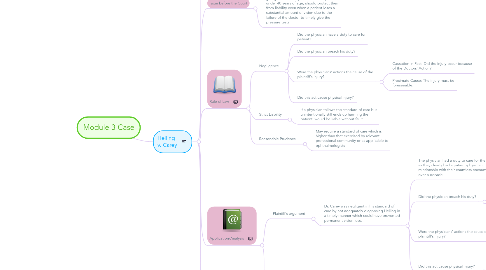
1. Helling v. Carey
1.1. Facts
1.1.1. Parties
1.1.1.1. Mrs. Barbara Helling (Plaintiff)
1.1.1.2. Dr. Thomas F. Carey (Defendant)
1.1.2. What happened
1.1.2.1. Barbara Helling, (petitioner) complained of nearsightedness and consulted with Dr. Carey in 1959. She was fitted with contact lenses.
1.1.2.1.1. 1963 Mrs. Helling consulted with Dr. Carey, concerning irritation caused by the contact lenses.
1.1.2.1.2. Additional consultations occurred in Oct, 1963, Feb, 1967; Sept, Oct 1967; May, July, Aug, Sept 1968.
1.1.2.1.3. October 1968, Mrs. Helling's eye pressure was tested and field of vision for the first time.
1.1.3. Procedural History
1.1.3.1. Helling filed suit alleging she sustained severe and permanent damage to her eyes as a proximate result of the Doctors' negligence.
1.1.3.2. The trial court entered judgment for the defendants following a defense verdict.
1.1.3.3. Helling appeals, the judgment of the trial court and the decision of the Court of Appeals is reversed, and the case is remanded for a new trial on the issue of damages only.
1.2. Issue before the Court
1.2.1. Whether the defendants' compliance with the standard of the profession of ophthalmology, which would require the giving of a routine pressure test to persons under 40 years of age, should protect them from liability even when a patient loses a substantial amount of vision due to the failure of the doctor to timely give the pressure test?
1.3. Rule of Law
1.3.1. Negligence
1.3.1.1. Did the physician have a duty to care for patient?
1.3.1.2. Did the physician breach his duty?
1.3.1.3. Were the physicians' actions the cause of the plaintiff's injury?
1.3.1.3.1. Causation in Fact: Did the injury occur because of the Doctors' Action?
1.3.1.3.2. Proximate Cause: The injury must be foreseeable.
1.3.1.4. Did this act cause physical injury?
1.3.2. Strict Liability
1.3.2.1. If a physician follows the standard of care but unintentionally still ends up harming the patient, would be liable without fault.
1.3.3. Reasonable Prudence
1.3.3.1. May require a standard of care which is higher than that exercised by relevant professional community or as applicable to ophthalmologists
1.4. Application/Analysis
1.4.1. Plaintiff's argument
1.4.1.1. Dr. Carey was negligent in his standard of care by not adequately diagnosing Helling in a timely manner which could have prevented permanent vision loss.
1.4.1.1.1. The physician had a duty to care for the patient as they clearly had a patient-physician relationship with their countless encounters over a decade.
1.4.1.1.2. Did the physician breach his duty?
1.4.1.1.3. Were the physicians' actions the cause of the plaintiff's injury?
1.4.1.1.4. Did this act cause physical injury?
1.4.2. Dr. Carey's argument
1.4.2.1. According to the Standards of the profession for Optomology, do not require routine pressure tests for glaucoma upon patients under 40 years of age.
1.4.2.1.1. The physician performed services per Standard of Care as a pressure test was only expected for patients 40 and above. The patient who experienced this issue was only 32 at the time of being diagnosed.
1.5. Conclusion
1.5.1. The judgement of the trial court and the decision of the Court of Appeals was reversed on the issue of damages only: The defendant bore no wrongdoing in actions but since the Standards of Care did not protect patients under 40 years of age, the court imposed a strictly liability (compensatory) amount through the defendants insurance to bare the damages.
1.6. The impact of the decision
1.6.1. Gates v. Jensen (1979)
1.6.1.1. The Supreme Court required that ophthalmologist inform patient of abnormality related to pressure buildup in both eyes which put patient at high risk for glaucoma, and that reasonable prudence may require a standard of practice which is higher than that exhibited by similar professional community as applicable to ophthalmology.
1.6.2. Harris v. Robert (1983)
1.6.2.1. The Supreme Court in this case also imposed upon health care providers a standard of care of reasonable prudence, and not an “average practitioner” standard.
1.7. Why a healthcare professional would care about the decision and how it has changed the way health care operates?
1.7.1. A Healthcare professional would care about the decision because it affects his/her liability insurance premiums especially since standard of care was being followed. Additionally, healthcare professionals may feel that lawsuits are uncontrollable and unpredictable.
1.7.1.1. With this ruling, this has positively affected healthcare as optometrists apply the simple inexpensive pressure test as part of the routine eye checkup.
1.8. At least two current health care practices that have been influenced by the holding
1.8.1. Optometrists now routinely conduct the simple pressure test to evaluate glaucoma
1.8.2. Visiting an Emergency Room may now result in additional tests previously not required to comply with reasonable prudence and deter strict liability claims by conducting excessive tests when a reasonably prudent physician may not have requested prior to this ruling.

